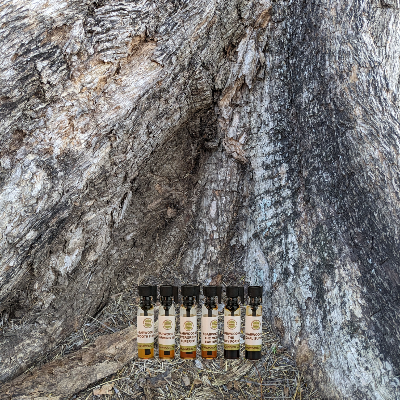Menu
-
-
F.A.Q
- How to identify genuine agarwood chip, natural or cultivated
- How to identify oil injection / absorption fake agarwood beads
- How to know if there are more than one oil in your oil
- How to make your wood bracelet or mala darker
- How to tell if an Agarwood bead sinks WITHOUT sinking it under water?
- How does back flow incense work and how do you burn it?
- Where to start if you don't know what agarwood is ?
- Why are you losing money if you buy seeds and plants?
- Which agarwood incense should I choose?
- Frequently Asked Questions
- Agarwood Related Articles
- Shipping
-
SHOP - Agarwood
-
SHOP - Other Fragrant Wood
-
SHOP - Incense Holder and Burner
-
- FREE Oud Oil guide
- Testimonials
- "Why did you buy this?"
- Contact us
- About Us
- +61430284329
- Login
-
English


Why does one Agarwood smell different from another? Factors that affect the aroma of Agarwood oil
July 09, 2023 10 min read
Table of Contents:[hide]
Have you been craving the captivating scent of real agarwood oil, only to be let down by “dull” Oud oil?
You are not the only one. Many people have spent a significant amount of money on agarwood oils that just were not worth it. It is frustrating and makes you question if there is even such a thing as real oud oil anymore.
I understand how annoying not to get what you want: deep, complex, booming vanillic woody notes.
But all you get are adulterated ones that do not come close to the aromatic ones that only the real deal can give.
Even though some oud oils are genuine, you feel dull when you smell them. You wonder why?
Today I may have answers for you. I will discuss many factors that affect the aroma of Agarwood.
Why does one Agarwood smell different from another?
Agarwood oil, prized for its complex and alluring fragrance, can have its aroma profile significantly influenced by various factors. Here we discuss three main factors: the method of distillation, the quality of the raw material, and the craftsmanship involved.
The Method of Distillation:
- a) Hydrodistillation: In hydrodistillation, agarwood chips are immersed in water, and the mixture is then heated. The steam containing the essential oil is condensed and collected. This method often results in a rich, deep aroma as prolonged exposure to heat allows for the extraction of lighter, more volatile aromatic compounds. As a result, your nose detects more potent, vivid aroma notes. However, hydrodistillation can sometimes result in the loss of some of the more delicate heat-sensitive ones.
- b) CO2 Supercritical Fluid Extraction: In supercritical fluid extraction, carbon dioxide is used as a solvent under high pressure and temperature. This method tends to extract a wider range of aromatic compounds, including some of the more delicate ones that may be lost during hydrodistillation. The result is often a more rounded and nuanced fragrance profile. Supercritical fluid extraction also tends to produce a purer product with less water content. However, many people experienced that oils extracted using this method is not as “potent” as hydrodistilled method
Co2 Supercritical fluid extraction (CSFE) is more effective at extracting heavier compounds than hydrodistillation. This is because CSFE uses a supercritical fluid CO2, a substance brought to a temperature and pressure above its critical point. At this point, the fluid has no distinct liquid or gas phase, and it can dissolve both polar and nonpolar compounds. This makes it a very versatile solvent for extracting a wide variety of compounds from plant material. CO2 is also odourless, which is an important factor. You would not want to smell anything else rather than pure oil, would you?
In contrast, hydrodistillation uses steam to extract essential oils from plant material. Steam is a good solvent for extracting volatile compounds but is not as effective at extracting heavier compounds. This is because steam has a relatively low boiling point and cannot dissolve as many compounds as a supercritical fluid.
As a result, CSFE is often used to extract heavier compounds from plant material, such as terpenes, waxes, and pigments. Hydrodistillation is more commonly used to extract volatile compounds, such as essential oils.
That is why CSFE Agarwood oils are heavier, denser. They sink in water

But it does not mean Co2 oil has "better quality" than Hydrodistillaiton oil?
Not really
Different method of extracting the oils will provide different chemical compounds so they smell different.
Here is a table that summarises the key differences between SFE and hydrodistillation:
|
Feature |
Supercritical fluid extraction |
Hydrodistillation |
|
Solvent |
Supercritical fluid (usually CO2) |
Steam |
|
Boiling point |
Varies depending on the fluid |
100°C |
|
Polarity |
Can be polar or nonpolar |
Polar |
|
Extraction efficiency |
Higher for heavier compounds. Aroma is not as “strong” Oil is more viscous and denser |
Higher for volatile compounds. More complex aroma Oil body is medium |
|
Extraction time |
Longer |
Shorter |
|
Equipment Cost |
Higher |
Lower |
Just in case you want to try, we have both of the samples set
100% Pure Hydrodistilled Agarwood Essential Oil

100% Pure CO2 Supercritical Fluid Oud Oil

OK, let’s look at the next two factors influencing the aroma of Agarwood oil
The Material - Agarwood:
- The quality of the agarwood in the distillation process is critical. High-quality agarwood has a higher content of resin, which is where the fragrance compounds are concentrated. More resinous agarwood will yield an oil with a richer, more potent fragrance. Conversely, lower-quality agarwood with less resin will produce oil with a lighter and less distinctive aroma.
The age of the agarwood in the Aquilaria tree is a major factor in the quality of the oil because the resin that gives agarwood its characteristic aroma only develops in older trees.
This resin is produced by the tree in response to injury or stress, and it takes many years for the resin to develop to its full potential. The the infection prolongs, the Aquilaria tree creates more Agarwood. The longer period, the better the quality usually. It is called the age of infection. In the wild trees grow undisturbed. If the tree has Agarwood, it is usally there for decades before being harvested
As the infection ages, the resin becomes more concentrated and complex, resulting in a deeper, richer aroma. This is because the resin is made up of a variety of volatile compounds, and the older the tree, the more of these compounds are present. When we grow Aquilaria tree, the age of infection is around 2 to 3 years.
Climate is another factor. Aquilaria trees "absorb" the flavours and aromas of their surroundings. This can give the oil a more complex and nuanced aroma.
Aquilaria trees that are grown in warm, humid climates are more likely to produce a higher quality oil than trees that are grown in cold, dry climates. This is because the warm, humid climate promotes the growth of the resin that gives agarwood its characteristic aroma.
For example, agarwood that is harvested from trees that have grown in coastal areas may have a salty or marine aroma, while agarwood that is harvested from trees that have grown in mountainous areas may have a more earthy or woody aroma.
Submerge Agarwood chips under water will release volatile compounds making the chips smell better
You see, this action will give you an idea of how good the aroma is.
Let me explain
Wood contains a variety of volatile organic compounds (VOCs), which are chemicals that evaporate easily at room temperature. These VOCs are what give wood its natural scent. When wood is submerged in water, the water molecules can dissolve some of these VOCs, carrying them away from the wood. This can temporarily reduce the intensity of the wood's scent.
However, once the wood is removed from the water, the VOCs will slowly evaporate back into the air. This can actually make the wood smell stronger than before, as the VOCs are now more concentrated. Additionally, the water molecules may have also washed away some of the impurities in the wood, which can also contribute to a more pleasant scent. And this happens to Agarwood too.
When you soak wood in water, it can actually cause some of the compounds within the wood to release, creating a stronger aroma. And when you soak Agarwood long enough, the water can start to break down the cell walls in the wood, which then releases oils and other organic compounds that have distinctive smells. Timing is critical, if it is too short, the VOCs are not fully released and if it is too long, the wood would rot, create “rotten” smell.
Because of this, the skill of distiller is important which we will discuss next
Craftsmanship
The distiller's skill and knowledge play an integral role in the quality of agarwood oil. An experienced distiller understands the intricacies of temperature control, pressure levels, timing, and pre-distillation preparation of the raw material. Additionally, the curing process post-distillation can affect the maturity and depth of the aroma. Attention to these details is crucial in optimising the extraction of aromatic compounds and achieving a superior fragrance profile.
Temperature control: The temperature of the water during distillation can affect the extraction of the aromatic compounds. If the temperature is too high, the compounds will evaporate too quickly and will not be captured in the oil. If the temperature is too low, the compounds will not evaporate at all.
Pressure levels: The pressure of the water during distillation can also affect the extraction of the aromatic compounds. If the pressure is too high, the compounds will be forced out of the wood too quickly and will not be captured in the oil. If the pressure is too low, the compounds will not be forced out of the wood at all.
Timing: The timing of the distillation process can also affect the quality of the oil. If the distillation is stopped too early, the oil will not be as concentrated. If the distillation is stopped too late, the oil will become too thick and will not be as pleasant to smell.
Pre-distillation preparation of the raw material: The way that the raw material is prepared before distillation can also affect the quality of the oil. If the wood is not properly dried, the oil will not be as concentrated. If the wood is not properly cleaned, the oil will be contaminated with impurities.
Curing process post-distillation: The curing process post-distillation can also affect the maturity and depth of the aroma. If the oil is not cured properly, the aroma will not be as complex or as pleasant.
At Grandawood, we understand that controlling these factors is vital for producing agarwood oil with a desirable and high-quality aroma.

Feedback of Evergreen and Smooth Oud Oud Oil from a perfumer who wishes to remain discreet
My Journey to Authenticity: Discovering Grandawood’s Oud Oil
Being a perfumer is a fascinating job, but it's not without its trials. The olfactory world is full of synthetic substitutes and diluted versions, and finding authentic ingredients is often a herculean task. That is not a bad thing. I have been using synthetic as most of the synthetic substitutes are environmentally friendly. After all, it is about safety and feeling good.
But when one client asked me to create an Oud perfume using only essential oil and botanical extracts, I still happily accepted the project.
So I have been on a quest for the ultimate scent – the elusive agarwood oil.
Once I got the deposit from my client, I invested countless hours and a significant portion of my budget, attempting to source it. But most of my ventures led me to counterfeits or weak adaptations that fell short of the rich, complex scent profile I sought.
A perfumer's palate, much like a wine connoisseur's, craves authentic notes. I longed for a scent that would surprise me, taking me on a sensorial journey to the aromatic heartlands of an agarwood forest. However, repeated disappointments had me questioning my nose. I began to fear my olfactory senses were dulled, or worse, that genuine agarwood had vanished.
Synthetic Oud compounds are great. But their notes are not as vibrant as the real one. I learnt that there are more than 200+ chemical compounds from Agarwood oil, something that the chemists cannot fully synthesize yet.
Then, I discovered Grandawood's "Super Smooth Floral" Oud Oil through a Facebook Group. I had a chat with Trent and ordered the Smooth Oud oil

From the moment it arrived, I was grateful as Trent kindly sent me his Evergreen Superior Oud too.

I sensed something unique. It possessed a full-bodied, potent sillage that was head and shoulders above anything I'd previously encountered. Its name might suggest a gentle, blooming bouquet, but in reality, it delivered an unexpected depth, brimming with exotic and intensely floral notes.
Upon the first olfactive evaluation, the oil uncurled its olfactory narrative. With a hint of animalic undertones interlaced with spicy accents of nutmeg and mace, it evoked an intriguingly multifaceted and profound riveting sensory experience.
As the oil dried down, the real magic happened. Like an olfactory evolution, it slowly transported me into the verdant heart of an agarwood forest. The scent's tenacity and diffusion evolved, spinning a complex web of aromatic dimensions around me, so vivid I found myself checking for metaphorical snake bites.
In the act of experiencing Grandawood's Oud Oil, I embarked on an olfactory odyssey that exceeded all my anticipations. This was the true agarwood essence I had desired, an authentic olfactive journey worthy of my investment.
A sense of relief washed over me, replacing past frustrations with renewed excitement. Authentic agarwood wasn't extinct; it had been captured here within the enchanting complexity of Grandawood's "Super Smooth Floral." and Evergreen Superior
So, to fellow perfumers yearning for a genuine agarwood experience, I recommend two of the Grandawood oil: Smooth Oud and Evergreen. These duo of striking authenticity and captivating layers will transport you on a unique olfactory journey. Say goodbye to settling for subpar ingredients. The essence of agarwood is here, waiting to be unearthed, explored, and savoured.
Would you like to give these sample sets a try?
100% Pure Hydrodistilled Agarwood Essential Oil
100% Pure CO2 Supercritical Fluid Oud Oil
Summary
- The aroma of agarwood oil can vary depending on the method of distillation, the quality of the raw material, and the craftsmanship involved.
- Hydrodistillation is a traditional method of distillation that uses steam to extract the essential oil from agarwood. This method can result in a rich, deep aroma, but it can also lose some of the more delicate heat-sensitive compounds.
- Supercritical fluid extraction (SFE) is a newer method of distillation that uses carbon dioxide as a solvent. This method can extract a wider range of aromatic compounds, including some of the more delicate ones that may be lost during hydrodistillation.
- The quality of the raw material is also important. Agarwood that is harvested from older trees will typically have a richer, more complex aroma.
- The craftsmanship involved in the distillation process can also affect the aroma of the oil. A skilled distiller will be able to extract the essential oil in a way that preserves the delicate aromatic compounds.
Overall, I hope the discussion provides a comprehensive overview of the factors that can affect the aroma of agarwood oil. At Grandawood, we understand these factors and apply the science behind to provide high-quality agarwood oil with a rich, complex aroma.
Leave a comment
Comments will be approved before showing up.
Also in News

What is Tasbih? The Deep Meaning of Subhan Allah and the Role of Prayer Beads
November 09, 2025 4 min read
